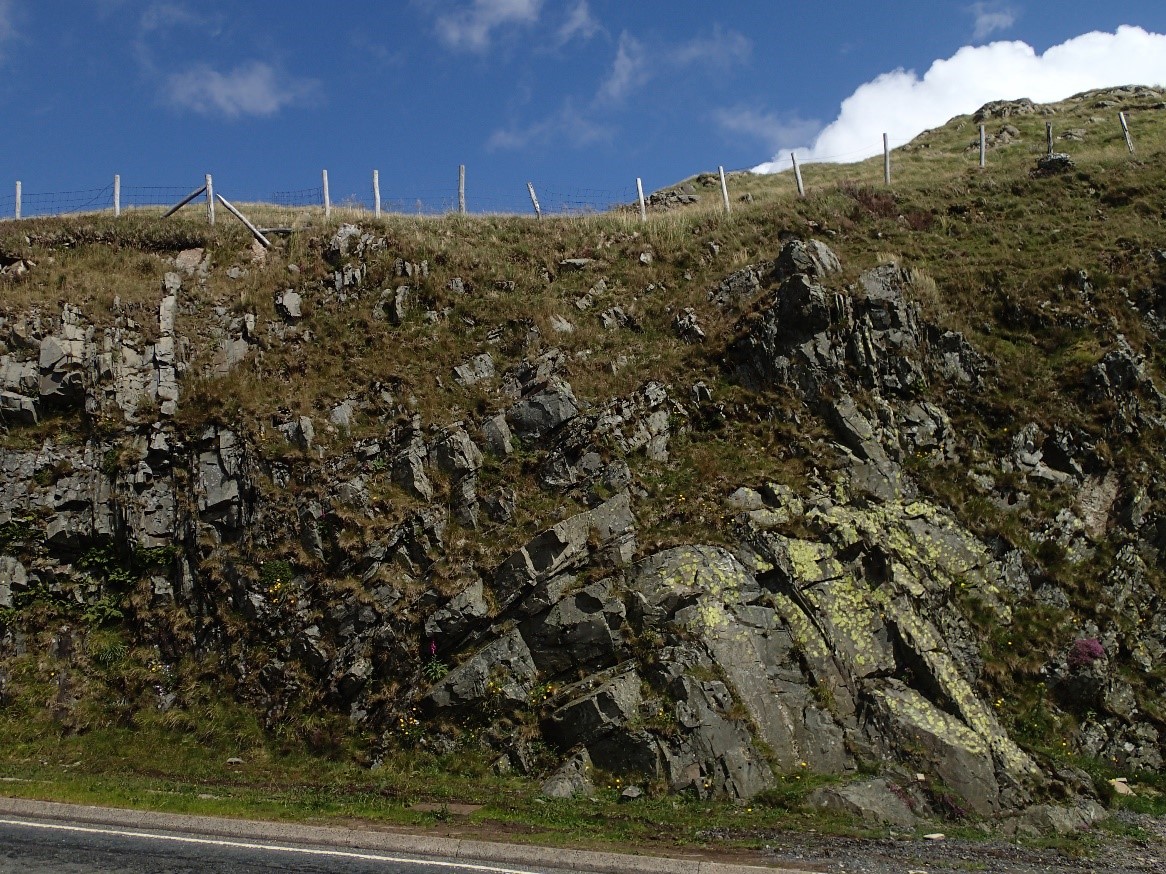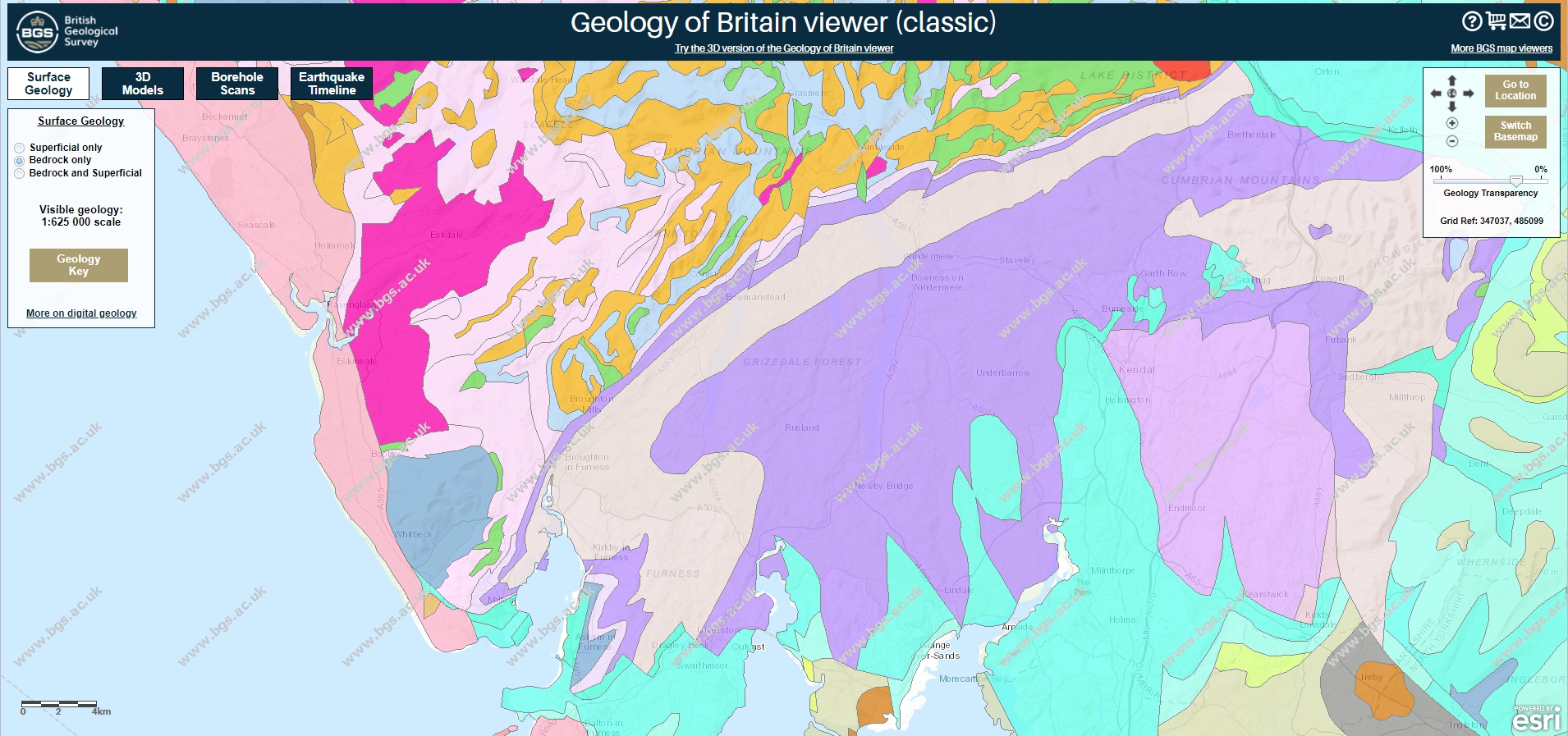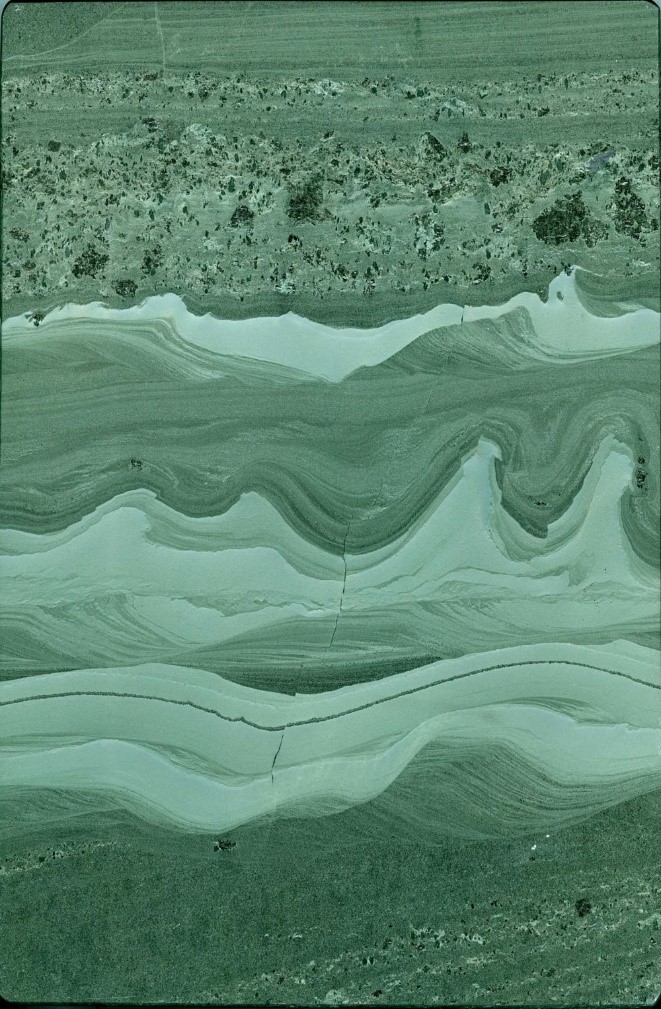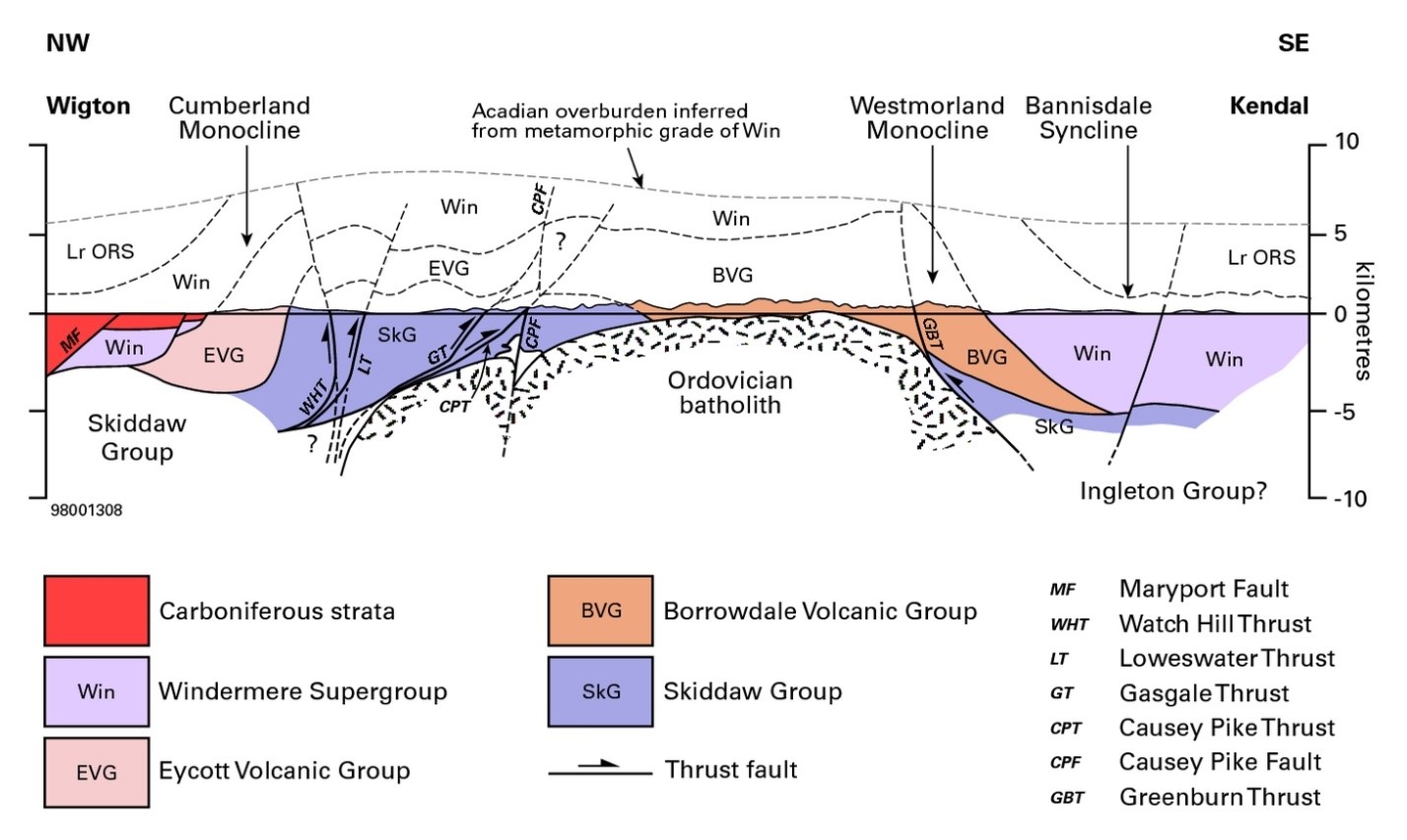ACADIAN OROGENY

ACADIAN OROGENY

Accretionary lapilli from the Tilberthwaite Formation, Kentmere looking along the slaty cleavage to display the highest strain. Before the Acadian Orogeny the accretionary lapilli would have been close to spherical or slightly elliptical aligned approx. along the bedding. This rock has been considerably shortened at right angles to the cleavage plane.
The Acadian Orogeny turned mudrocks throughout most of the Skiddaw, Borrowdale, and Eycott groups, and the Windermere Supergroup, into slates. That takes quite a bit of deformation and where this has been quantified the mudrock precursor to the slate has been shortened between 50 and 70%. This was a vice-like process that not only involved direct convergence but also significant horizontal sliding motion; a transpressive event. Production of a slate belt was not the only result of this deformation. Folds and faults were also imprinted on the pre-Acadian successions in a low-grade regional metamorphic episode. The youngest rocks affected by the orogeny were deposited late in the Silurian and before they could be transformed into slates they had to be buried under kilometres of overburden to increase their temperature and to allow them to flow in a ductile fashion. What is debated is the amount of overburden. Estimates have ranged from three to eight kilometres with even ten being mentioned early in the discussion when it was first realized how much of the early Devonian rock record had been lost without trace. Perhaps somewhere in the middle of these estimates is reasonable?

Acadian folds, Bannisdale Formation at Crookdale Crags on the A6 just south of Shap Summit. All the original mudrocks in this exposure are now slates. Despite the deformation many sedimentary structures are evident including sole structures on the bases of turbiditic sandstones.
Folds are the most obvious expression of the Acadian deformation and they are seen on all scales from kilometric to hand-specimen. At regional-map scale the Windermere Supergroup stratigraphy highlights the biggest folds with amplitudes and wavelengths of kilometres as seen on the British Geological Survey’s GeoIndex Onshore map; these folds formed at the same time as the slaty cleavage. Less obvious on the GeoIndex map is the Westmorland Monocline which is the long line of consistently striking units along the boundary between the Borrowdale volcanics and the Windermere Supergroup. Such a persistent strike length is produced by an approximately six-kilometre-wide belt of very steeply dipping beds. Regional Acadian folds in the other sedimentary rock unit, the Skiddaw Group, are generally open structures as seen on cross sections on BGS 1:50,000 geological maps. In the Skiddaw Group individual bedding attitudes are varied and commonly steep but the attitudes of formation boundaries are gently curved and rarely steep. Coming down to exposure scale, folds are typically tight and exceptions are associated with thick competent units like sandy turbidites in a slaty background. The original term of Skiddaw Slates certainly gave forewarning as to the state of the materials involved even though it only described some of the rock types. In contrast to the well-layered, dominantly sedimentary sequences, Acadian folds in the Borrowdale volcanics are not common. In many areas within the BVG the overall attitude is of near-horizontal boundaries or moderate to gentle dips. Examination of detailed BGS maps for the BVG will show the contacts between different units either following topographic contours or not departing radically from that relationship. This pattern shows the protection afforded to the BVG during the Acadian Orogeny by the vast thickness of the granite intrusions underlying the BVG. When the stresses associated with the orogeny were being applied the Lake District Batholith acted as a rigid mass that could not be shortened leading to a broad swathe of the BVG not being cleaved or folded and the preservation of original features both volcanological and sedimentological. Looking at regional maps it might be tempting to invent orogenic deformation between the Borrowdales and the Windermere Supergroup because of the angular nature of the relationship. The base of the Dent Group truncates boundaries within the Borrowdales especially south of Coniston again clearly seen on the GeoIndex map. Rather than searching for a compressive plate tectonic process to explain these observations attention turned to volcano-tectonics. Piecemeal caldera collapse creates substantial faults with hundreds of metres of offset and block rotation affects blocks of kilometric dimensions. This style of behaviour can explain the angular discordance above and below the Borrowdales/Windermere Supergroup unconformity. The major syncline in the Central Fells has been attributed volcano-tectonics.

Regional-scale Acadian folds in the Windermere Supergroup from Millom to just east of Sedbergh, a distance of approximately 56 km. British Geological Survey, Geology of Britain Viewer, copyright UK Research and Innovation [more detail is available if you visit the British Geological Survey's GeoIndex Onshore].
A single slaty cleavage was imposed on all the pre-Acadian stratigraphy though in places it may not look as if the effects of the orogeny were so straightforward. In mud dominated formations of the Skiddaw Group the rock properties meant that subsequent deformations could have a greater impact on the earliest-formed structures than in the Borrowdales or the Windermere Supergroup suggesting to some that there was an orogenic event between the Skiddaw Group and the volcanics. One fairly-widespread second deformation feature in the Skiddaw Group was the development of folds with gently-dipping axial surfaces. Folds of this attitude form because during slaty cleavage event the whole rock mass was stretched vertically and, when the compressive stress was removed, the weight of the extended rocks caused vertical collapse. Such folds are referred to as sideways closing or recumbent and they fold the first-formed folds and its associated slaty cleavage. Once a mudrock is cleaved any later deformation will normally produce a crenulation cleavage which is a cleavage caused by microfolding of the slaty cleavage and which creates a very distinctive lineation style. A very minor separate deformation event created abrupt deflections of bedding together with the slaty cleavage giving rise to the name kink-fold. This style folds both laminated sedimentary layers but more commonly slaty cleavage and it is not welcome in slate quarries because blocks of slates with kink-bands cannot make roofing slates or dinner table place mats!

Acadian slaty cleavage axial planar to folds of silty/sandy packages in what was originally a mud dominated sequence, Kirkstile Formation, Skiddaw Group. Between Hopegill Head and Ladyside Pike NY 18590 22318. 50p coin for scale.

Sideways closing folds folding the slaty cleavage, Kirkstile Formation, Skiddaw Group. Between Hopegill Head and Ladyside Pike NY 18590 22318.

Acadian folds in the Skiddaw Group, Sinen Gill within the inner zone of the Skiddaw Granite contact metamorphic aureole. The folds have metric-scale amplitudes and wavelengths; the cleavage is essentially axial planar.
If you look down the plunge of the first folds to have formed, the slaty cleavage is clearly geometrically related to the folds in that it comes close to splitting the angle between the fold limbs. Strictly speaking this relationship only holds at the fold closure for folds where the material properties of the folded layers vary considerably as in the turbiditic parts of the Windermere Supergroup. Also on the fold limbs the slaty cleavage can splay in a fan even if there are no great lithological contrasts. If the folded layering has markedly different physical properties the first cleavage to form can appear to have very different morphology from layer to layer. This is at its most extreme in a multilayer of coarse turbiditic sandstones and original mudrocks as in much of the Coniston Group. Here appearances are deceptive because the cleavage in both rock types is spaced in that it does not affect all parts of the rock equally. The only difference is the actual spacing. In the slate the cleavage planes are so close together that in the field you normally do not see the less cleaved areas whereas in the sandstones the less or non-cleaved parts are easily seen. The simplicity of the geometrical relations in the section view through the folds is complicated in the map view where the trend of the cleavage is a little oblique to the trend of the folds. This difference has been used by some authors to interpret the main phase of Acadian deformation as sinistrally transpressive though this analysis has been disputed by others.

Slaty cleavage at high angles to bedding in resedimented volcaniclastics, Caw Formation, Borrowdale Volcanic Group, SW slopes of Caw. Weathering has etched the cleavage planes emphasizing the spaced nature of the cleavage even though it is fairly pervasive.

Cleavage refraction from a slate to a turbiditic sandstone, Gawthwaite Formation, Gawthwaite Moor. In the lower sandstone the cleavage is crudely spaced at around 2 cm intervals. 20p piece for scale.

A dinner-table place-mat of green slate from the Borrowdale Volcanic Group looking onto the cleavage plane. Despite the around 60% shortening that this rock has undergone, original features are preserved in exquisite detail. The lowest layer is a turbidite and its Bouma C division was draped by mud but it took another three/four depositional events before that topography was eliminated by a slightly thicker turbidite, which is mainly Bouma C, but which has A and B divisions localized in troughs present at the time of deposition. The pillars of mud above this are diapirs/flames created by soft-sedimentary deformation. The thickest layer above this is a debris flow deposit as indicated by the lack of sorting and the larger andesite clasts supported by the muddy matrix. The debrite has clasts sticking out of its top surface showing the strength materials as they flow. These volcaniclastic deposits formed in a caldera lake.
A glance at any geological map of the Lake District, at anything other than the smallest of scales, will reveal multitudes of faults. Faults have been created in many phases of Lake District history. The following events have probably all generated new faults: basement tectonics of the Lakesman-Leinster terrane prior to Skiddaw Group deposition, extensional tectonics as the Avalonian Superterrane pulled away from Gondwana, initiation of subduction, volcano-tectonics in the Borrowdales, the transtensional regime post-collision and pre- Acadian, Acadian deformation, late Devonian to early Carboniferous lithospheric stretching, Variscan deformation, and various rifting events associated with the Atlantic opening, plus far-field effects of the Alpine compression. It is no wonder that Cumbrian faults are many and varied. In considering the list of what events created faults we have to bear in mind varying degrees of reactivation in subsequent deformation episodes. For the moment we shall look at Acadian faulting both as new fractures created in this event and those older fractures reused at this time.

Pattern of faults cutting the Windermere Supergroup in the southern Lake District (after Soper and Woodcock, 2003). Figure 35 in Stone, P, Millward, D, Young, B, Merritt, J W, Clarke, S M, McCormac, M and Lawrence, D J D. 2010. British regional geology: Northern England. Fifth edition. Keyworth, Nottingham: British Geological Survey. Earthwise P916065, copyright UK Research and Innovation. More detail can be obtained by viewing the British Geological Survey's GeoIndex Onshore.
When it was realized that Iapetus closure took place in the early to mid-Silurian, it seemed reasonable to extend the implications of the tectonic setting and to interpret Skiddaw Group structures as a fold-and-thrust system created by the overriding of Avalonia by Laurentia. The model proposed that thrust sheets were emplaced over the Borrowdale volcanics and that the Acadian orogeny was driven by continuing Avalonia-Laurentia convergence. However, key aspects of this model did not match timing constraints both stratigraphic and radiometric, and the model has not been supported. Current thinking does not equate any of the major structures in the Skiddaw Group to the soft docking of the Avalonia Superterrane with Laurentia. Skiddaw Group structure is dominated by ENE trending faults the most significant of which is the Causey Pike Fault. This fault extends all the way through the main Skiddaw Group outcrop and can be traced to the Cross Fell inlier. A down dip offset of approximately two kilometres indicates the importance of this fault which separates domains with differing slump fold orientations and sedimentary provenance. Clearly it was operating during sedimentation and was likely to have been an extensional fault during rifting. Acadian strike-slip reactivation is inferred along its eastern trace whereas in the west reverse/thrust movement is demonstrated because it offsets the Crummock Water aureole which is an early Devonian feature. The Gasgale, Loweswater, and Watch Hill thrust faults, have the same trend as the Causey Pike but they have evidence for initiation as slide planes during the formation of major soft-sedimentary slumps. Again Acadian reactivation is evident because of the change in orientation of Acadian structures [folds and main cleavage] close to these faults. The Acadian reworking of early faults in the Skiddaw Group shows on the Lake District scale cross-section as a spread of attitudes known as a flower structure.

Simplified cross-section of the Lake District showing the overall anticlinal form defined by two outward-facing monoclines [Cumberland & Westmorland] with the Lake District batholith at its core, the internal Skiddaw Group flower structure, and the possible extent of overburden at the time of Acadian deformation. Earthwise P916060. Figure 30 Stone et al. 2010 British Regional Geology, Northern England, Fifth Edition, BGS. After Woodcock & Soper, Figure 6.5 in Brenchley & Rawson [eds] The Geology of England and Wales, 2006.
Prominent northerly trending faults in the Windermere Supergroup can be shown to have been active during the Acadian Orogeny because folds have evolved somewhat separately in adjacent fault blocks. These probably are reused pre-Skiddaw Group faults and may well have moved during the Borrowdales volcanic episode. Such a history requires that they propagated into the cover rocks in the episodes of reactivation. Several significant faults belong to this group including the Coniston [1.5 km], Brathay [1.7 km], and Troutbeck faults [1.2 km]. The distances quoted are offsets of the basal WSG unconformity along the strike of the faults. A common observation is that Acadian faults with small displacements have a much greater topographic expression than volcanotectonic faults with significantly larger amounts of movement.

The view from inside an Acadian brittle fracture zone looking out: Cust’s Gully looking north towards Skiddaw via Sprinkling Tarn and Derwent Water. There is no discernable offset on the fracture yet it is deeply etched by erosion because it is a set of closely-spaced microfaults and joints.
An integral part of the Acadian Orogeny is the magmatic episode that made its presence felt towards the end of the orogeny. This component is known as the Trans Suture Suite of granitic intrusions which straddle the Iapetus suture in a 100 km wide belt. Because this collection of intrusions post-dates the collision of Avalonia and Laurentia by perhaps more than 30 myr it was not generated in the same way as arc volcanics where devolatilization of the subducting plate triggers melting in the overriding plate. This suite of intrusives was formed when the Laurentian continental materials resisted subduction and the oceanic part of that plate dropped off and sank into the mantle in a process known as delamination. Upwelling asthenosphere heats the base of the overriding plate triggering a major magmatic event which in our case is seen either side of the suture rather than just on one side as in arc-forming events. Most emplacement ages for these granites are between 398 and 410 Ma and significantly for the Acadian Orogeny many were emplaced right at the end of cleavage development. The Shap and Skiddaw plutons belong to this group as does the Crummock Water Intrusion which is a concealed granite in the Skiddaw Group. Recent radiometric age determinations on the Skiddaw Pluton give ages of 398.8 ± 0.4 Ma and 399 ± 0.4 Ma. Textural analysis has shown that in the innermost contact-metamorphic zone andalusite grew over the slaty cleavage but the fabric slightly wraps the porphyroblasts. This means that the main Acadian deformation partially outlived the growth of the contact metamorphic minerals close to the granite. In outer zone of the aureole chiastolite entirely post-dates the slaty cleavage which means that the main Acadian deformation was complete by the time heat from the granite was conducted to the distant edge of the aureole in a matter of a few hundred thousand years. We therefore have a reliable date for the end of the slaty cleavage development of about 399 Ma. It could take as little as three million years to accumulate the 60% shortening needed to create the cleavage but it could be as much as ten million years as we do not have any way of measuring the strain rates during the orogeny and can only extrapolate a reasonable range of modern rates back in time.

Summary of key events that constrain the dating of the Acadian Orogeny in the Lake District together with relevant data from further afield. Figure 7 Woodcock et al. 2019 Proceedings of the Yorkshire Geological Society, vol. 62, pp. 238-253. Open Access article, Creative Commons Attribution License [http://creativecommons.org/licenses/by/4.0/].
Modern analysis of the Shap Pluton has revealed a remarkably long magmatic history for this member of the Trans Suture Suite. Zircon grains within this granitic rock [a biotite monzogranite] are multiply zoned and tiny samples of small numbers of zones have produced a wide range of ages using an ion microprobe from 428 to 403 Ma. It would appear that a crystal mush was held at mid-crustal levels in this time interval with batches of more mafic magma added periodically whilst the magma evolved until finally being rapidly emplaced into its current position. The ion probe work cannot date the final intrusion event because this would be given by the last zircon overgrowths which are too small to be analysed separately. Instead the study relied on a Re-Os date of 405.2 ± 1.8 Ma on magmatic molybdenite. This result implies that the slaty cleavage development was markedly diachronous between here and Skiddaw because at Shap the intrusion was also right at the end of the Acadian main phase of deformation. Is the slate belt deformation diachronous over 30 km or is the radiometric date not accurate? We await more data. Another surprise from the ion probe study is that the famous pink feldspar megacrysts started to grow ten myr before upper crustal emplacement.

Several benches near the centre of Workington are made of Shap granite. These pieces of street furniture are beautifully polished and display enclaves of microdiorite one of which has included a K-feldspar megacryst.
A minor but significant part of the Trans Suture Suite is the Shap Swarm which is a series of microgranite dykes related to the Shap granite or Shap biotite monzogranite to give it its correct classification. In the aureole of the Shap granite metamorphic minerals overgrow the Acadian slaty cleavage but the cleavage deflects around the pluton, a pattern that could be caused by distortion from the intruding granite or by a last small component of the main Acadian deformation. Some dykes in the Shap Swarm are cleaved on their margins which proves that the Shap Pluton was emplaced at high crustal levels late in the Acadian Orogeny.

A summary of key events between the closure of Iapetus and post-Acadian Devonian sedimentation in the Lake District.

